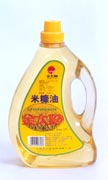
Rice bran
First, the product description:
Rice bran is a by-product of brown rice processing. Brown rice consists of four parts: exocarp, mesocarp, rice bran embryo and endosperm. Commercial rice bran is composed of exocarp, mesocarp, crosslinked layer, seed coat, rice bran and aleurone layer.
The chemical composition of rice bran is dominated by sugar, fat, and protein, and it also contains more ash and vitamins. The fat content varies depending on the variety, usually 12%-20%. The rice bran rice bran has a higher oil content than the japonica rice bran. Rice bran oil is generally prepared by direct leaching.ç³ ç²• can be used as feed. Rice bran contains about 5% of phytin, which can be produced to produce phytic acid and inositol.
Second, the custody method:
Rice bran contains a large number of lipases. The fat in the fresh rice bran can rapidly decompose under the action of the lipase, resulting in a large increase in free fatty acids. The freshly-frozen rice bran can increase 1% in free fatty acids at 25°C; fresh rice bran can be stored for one month and free fatty acids can be increased from 3% to 60-70%.
The most prominent problem in the storage period of rice bran is that it is extremely prone to rancidity and should not be stored for a long time. The method of instant oil extraction is often adopted in production, or the activity of lipase is destroyed in advance and the acidity is controlled to increase. According to the experiment, the newly-opened rice bran was heated for 10-15 minutes in 2-4 hours, and the temperature was brought to 95°C or higher, and the water content was reduced to 4-6%, so that the short-term storage was possible. After heating, the temperature reaches 115-120°C and the water content drops to 3-4%. The rice bran can be stored for about half a month.
Rice bran oil
Taken from rice, a by-product of rice processing. Rice bran accounts for approximately 6% (dry basis) of brown rice and is the highest oil content in rice grains (9%-22% of oil content). Rice is the most important food crop in the world and it is a potential source of bulk oil. Rice bran oil is produced in the United States and Japan. China is the world's major rice production area, and its output accounts for one-third of the world's production. Therefore, rice bran oil resources are extremely abundant.
Rice bran requires timely oil production, high oil yield, low acid value and light color. The rice bran contains more lipase. When the rice bran does not separate from the rice, as long as the rice is not mildewed, the activity of the lipase is very small, and it will not cause the rice bran to degenerate. When rice bran breaks away from brown rice within a few hours, lipase shows significant activity, quickly decomposes the oil in the rice bran and releases a large amount of fatty acids, resulting in a substantial increase in acid number.
The butter oil must be refined in time to remove mechanical impurities, lipase, microorganisms and free fatty acids.
The physical-chemical constants of rice bran oil:
Relative density (d20°C4°C) 0.9100-0.9250
Refractive index (n20°CD) 1.4700-1.4740
Viscosity (E020°C) 9.10
Freezing Point (°C)-5-0
Fatty Acid Freezing Point (°C) 24-28
Iodine value (g iodine / 100g oil) 98-110
Saponification value (mgKOH/100g oil) 182-188
Total fatty acid content (%) 94.2-96.4
Average molecular weight of fatty acids 278-285
Unsaponifiable (%) 5.6
The main fatty acid composition of rice bran oil (%):
Soft acid 15 or so
Stearic acid 1-2
Oleic Acid 44-46
Linoleic acid 35-36
Linolenic acid 1.3-2.5
Rice bran oil has very good antioxidant stability, mainly because it contains complex natural antioxidants. In addition to natural tocopherols (average total tocopherol content of 400 mg/kg oil), the oil also contains squalene and various ferulic acid esters, all of which contribute to antioxidant activity.
Refined rice bran oil is light yellow in color, oil contains more than 80% of unsaturated fatty acids, and the content of oleic acid is high, so the body's digestion and absorption rate of rice bran oil is relatively high. Rice bran oil has the function of reducing human blood lipids; it is a good edible oil. Due to the relatively high cost of rice bran oil refining and the low oil yield, rice bran oil can currently only be used in large quantities to make soaps, lubricating oils, and fatty acids. The use of physical deacidification to refine rice bran oil is being actively promoted.
The rice bran oil contains about 6% of wax, and the wax can be hydrolyzed to make triacontanol (commonly known as "mellowol"). The wax contains 10% triacontanol. Triacontanol is a plant growth hormone, 0.1-1.0ppm aqueous solution (1g "mellowol" can spray 20-200 acres of crops) can increase rice, wheat, corn, tomato and ovum, etc. 10% - 40%.
Second, the custody method:
Because rice bran oil is brought into the lipase during processing, it is prone to hydrolysis and rancidity, and the acid value rises quickly and is not easy to store.
Refined rice bran oil for fat removal